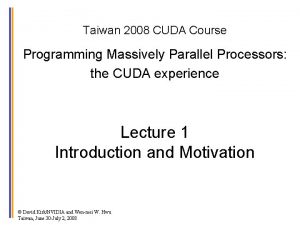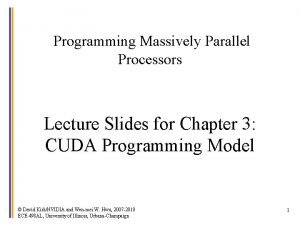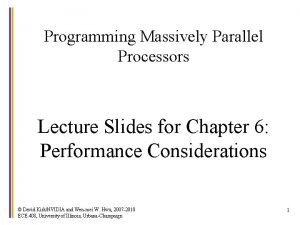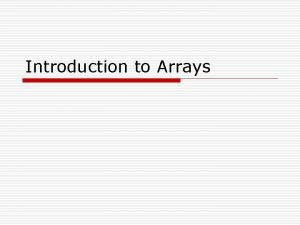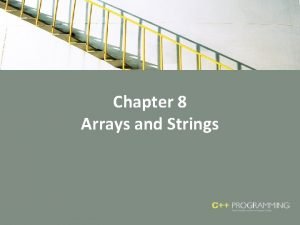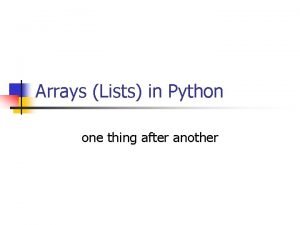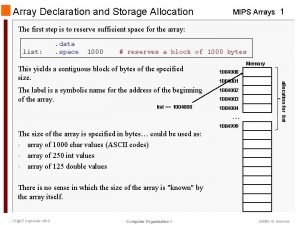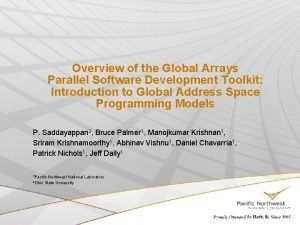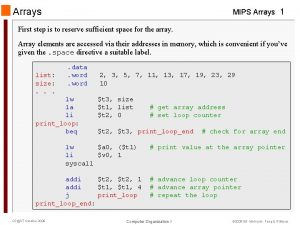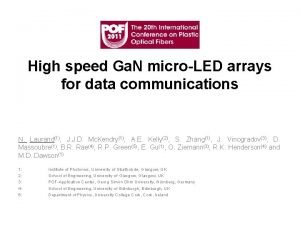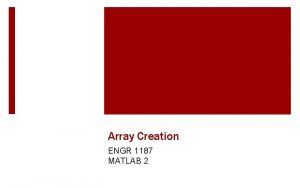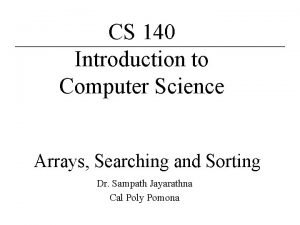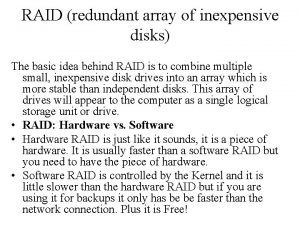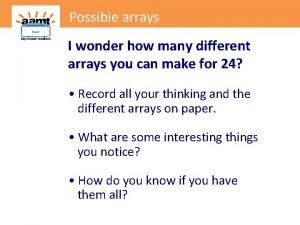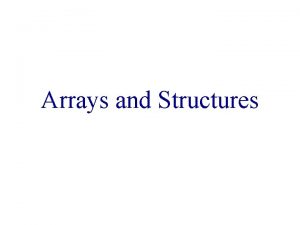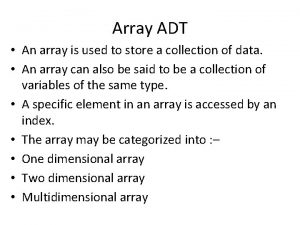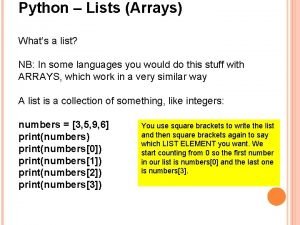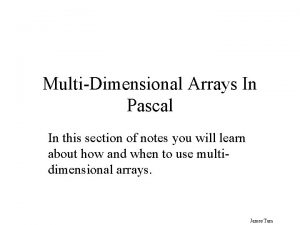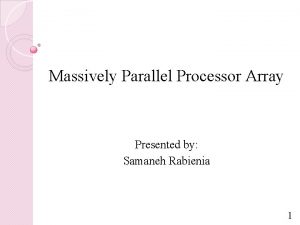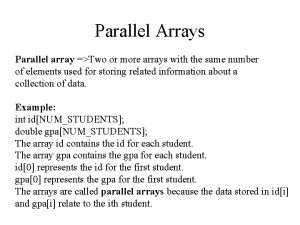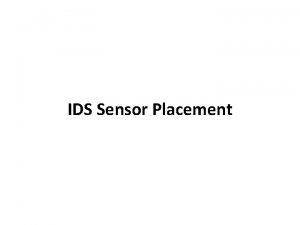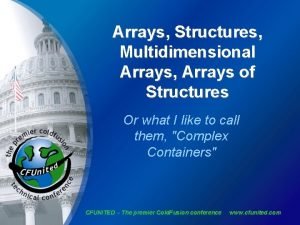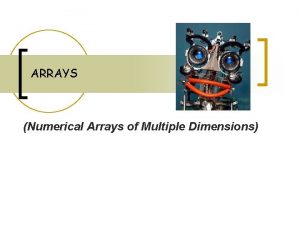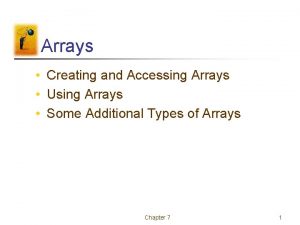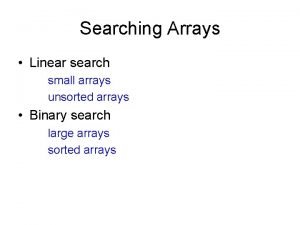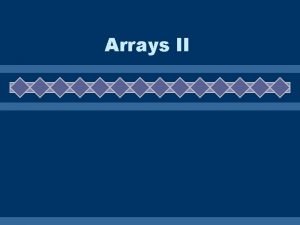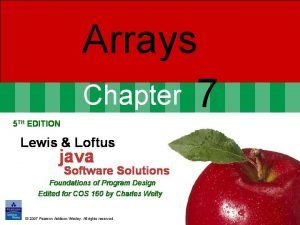SelfHosted Placement for Massively Parallel Processor Arrays MPPAs
































- Slides: 32

Self-Hosted Placement for Massively Parallel Processor Arrays (MPPAs) Graeme Smecher, Steve Wilton, Guy Lemieux Thursday, December 10, 2009 FPT 2009

Landscape • Massively Parallel Processor Arrays – 2 D array of processors • Ambric: 336, Pico. Chip: 273, As. AP: 167, Tilera: 100 – Processor-to-processor communication • Placement (locality) matters – Tools/algorithms immature 2

Opportunity • MPPAs track Moore’s Law – Array size grows • E. g. Ambric: 336, Fermi: 512 • Opportunity for FPGA-like CAD? – Compiler-esque speed needed – Self-hosted parallel placement • M x N array of CPUs computes placement for M x N programs • Inherently scalable 3

Overview • • • Architecture Placement Problem Self-Hosted Placement Algorithm Experimental Results Conclusions 4

MPPA Architecture • 32 x 32 = 1024 PEs • PE = RISC + Router • RISC core – In-order pipeline – More powerful PE than prev talk • Router – 1 -cycle per hop 5

Overview • • • Architecture Placement Problem Self-Hosted Placement Algorithm Experimental Results Conclusions 7

Placement Problem • Given: netlist graph – Set of “cluster” programs – One per PE C C C – Communication paths C C C • Find: good 2 D placement – Use simulated annealing – E. g. , minimum total Manhattan wirelength C C C C 8

Overview • • • Architecture Placement Problem Self-Hosted Placement Algorithm Experimental Results Conclusions 9

Self-Hosted Placement • Idea from Wrighton and De. Hon, FPGA 03 – Use FPGA to place itself – Imbalanced: tiny problem size needs HUGE FPGA – N-FPGAs needed to place 1 -FPGA design 10

Self-Hosted Placement • Use MPPA to place itself – PE powerful enough to place itself – Removes imbalance – 2 x 3 PEs to place 6 “clusters” into 2 x 3 array C 3 C 5 C 2 C C 0 C 1 C 2 C C 1 C 0 4 C C C 3 C 4 5 C C C C C 11

Regular Simulated Annealing 1. initial: random placement 2. for T in {temperatures} PE 1. for n in 1. . N clusters 1. Randomly select 2 blocks 2. 3. Compute swap cost Accept swap if i) cost decreases, or ii) random trial succeeds 12

Modified Simulated Annealing 1. initial: random placement 2. for T in {temperatures} PE 1. for n in 1. . N clusters 1. 2. 3. Consider all pairs in neighbourhood of n Compute swap cost Accept swap if i) cost decreases, or ii) random trial succeeds 13

Self-Hosted Simulated Annealing 1. initial: random placement 2. for T in {temperatures} PE 1. for n in 1. . N clusters 1. 2. 3. 4. Update position chain Consider all pairs in neighbourhood of n Compute swap cost Accept swap if i) cost decreases, or ii) random trial succeeds 14

Algorithm Data Structures • Place-to-block maps • Net-to-block maps PEs <x, y> Nets bnm bpm nbm pbm Blocks (programs) DYNAMIC STATIC 15

Algorithm Data Structures static pbm Full map in each PE bpm bnm Partial map in each PE nbm 16

Swap Transaction • PEs pair up – Deterministic order, hardcoded in algorithm • Each PE computes cost for own Block. ID – Current placement cost – After cost if Block. ID was swapped • PE 1 sends cost of swap to PE 2 – PE 2 adds costs, determines if swap accepted – PE 2 sends decision back to PE 1 – PE 1 and PE 2 exchange data structures if swap 17

Data Structure Updates Dynamic structures Local <x, y>: update on swap Other <x, y>: update chain Static structures Exchanged with swap 18

Data Communication Swap Transaction PEs exchange Block. IDs (already updated) PEs exchange nets for their Block. IDs PEs exchange Block. IDs for their nets 19

Overview • • • Architecture Placement Problem Self-Hosted Placement Algorithm Experimental Results Conclusions 20

Methodology • Three versions of Simulated Annealing (SA) – Slow sequential SA • Baseline, generates “ideal” placement • Very slow schedule (200 k swaps per T drop) • Impractical, but nearly optimal – Fast Sequential SA • Vary parameters across practical range – Fast Self-Hosted SA 21

Benchmark “Programs” • Behavioral Verilog dataflow circuits – Courtesy Deming Chen, UIUC – Compiled using RVETool into parallel programs • Hand-coded Motion Estimation kernel – Handcrafted in RVEArch – Not exactly a circuit 22

Benchmark Characteristics Up to 32 x 32 array size 23

Result Comparisons • Investigate options – Best neighbourhood size: 4 8 12 – Update chain frequency – Stopping temperature 24

4 -Neighbour Swaps 25

8 -Neighbour Swaps 26

12 -Neighbour Swaps 27

Update-chain Frequency 28

Stopping Temperature 29

Limitations and Future Work • These results were simulated on a PC – Need to target real MPPA – Performance in <# swaps> vs <amount of communication> vs <runtime> • Need to model limited RAM per PE – We assume complete netlist, placement state can be divided among all PEs – Incomplete state if memory is limited? • e. g. , discard some nets? 30

Conclusions • Self-Hosted Simulated Annealing – High-quality placements (within 5%) – Excellent parallelism and speed • Only 1/256 th number of swaps needed – Runs on target architecture itself • Eat you own dog food • Computationally scalable • Memory footprint may not scale to uber-large arrays 31

Conclusions • Self-Hosted Simulated Annealing – High-quality placements (within 5%) – Excellent parallelism and speed • Only 1/256 th number of swaps needed – Runs on target architecture itself • Eat you own dog food • Computationally scalable • Memory footprint may not scale to uber-large arrays • Thank you! 32

EOF 33
 Programming massively parallel processors, kirk et al.
Programming massively parallel processors, kirk et al. Programming massively parallel processors
Programming massively parallel processors Programming massively parallel processors
Programming massively parallel processors Programming massively parallel processors
Programming massively parallel processors Self hosted wikipedia
Self hosted wikipedia Java array operations
Java array operations Parallel arrays
Parallel arrays Python find index of max
Python find index of max Parallel arrays python
Parallel arrays python Arreglos unidimensionales en java
Arreglos unidimensionales en java Disadvantages of static memory allocation
Disadvantages of static memory allocation Mips array example
Mips array example Global arrays in c
Global arrays in c Veteork
Veteork Day 3: arrays
Day 3: arrays Redundant arrays of independent disks
Redundant arrays of independent disks Advantages and disadvantages of arrays
Advantages and disadvantages of arrays Arrays in mips
Arrays in mips Java arreglos bidimensionales
Java arreglos bidimensionales Microled arrays
Microled arrays Creating arrays matlab
Creating arrays matlab Computer science arrays
Computer science arrays Why do we need arrays?
Why do we need arrays? Raid redundant array of independent disks
Raid redundant array of independent disks I wonder is it possible
I wonder is it possible Polynomial representation using array in c
Polynomial representation using array in c Are vectors dynamic arrays
Are vectors dynamic arrays Arrays as adt
Arrays as adt Python list of arrays
Python list of arrays Searching and sorting arrays in c++
Searching and sorting arrays in c++ Dynamic arrays and amortized analysis
Dynamic arrays and amortized analysis Small basic arrays
Small basic arrays Arrays in pascal examples
Arrays in pascal examples
